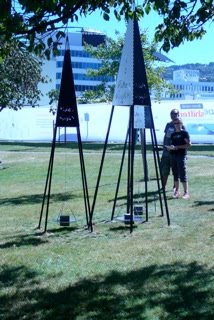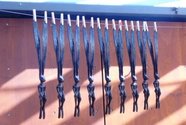Mark Amery – 11 March, 2010
It's one of those semi-Liliputian pieces of public garden design, squeezed into an acre with lots of different levels and spaces, a meandering stream and several hothouses for plants. This leads to you being offered a range of perspectives on the sculpture in situ as you move around the compact space.
Lower Hutt
Shapeshifter
Civic Gardens and The New Dowse
Graham Bennett, Saskia Baetens-Van Gil, Aaron Frater, Para Matchitt, Ben Caldwell, Christine Cathie, Oliver Stretton-Pow, Grant Palliser, Hannah Kidd, Matthew Browne, Tanya Ashken, Bronwyn Cornish, Don Driver
26 February - 21 March, 2010
John Hurrell used the words ‘sculpture garden’ in a review title on this site earlier this week. Usually the conjunction of these two words leads to a range of associations in terms of the type of art produced, not all of them good. All of which and more are on display in the festival exhibition Shapeshifter, outside the walls of the Seung Yul Oh “sculpture garden” installation (on which Hurrell wrote) at the Dowse.
Principally when I think of garden sculpture I think of inoffensive decorative standalone work, designed to reflect or work in elegant concert with its setting. As has been horribly apparent at events like the Ellerslie Garden show, national excellence in garden design often doesn’t carry over to innovative and distinct contemporary garden sculpture. With no disrespect to the wide range of excellent artists producing work in this field, too often garden sculpture exhibitions reveal a lower tier of borrowed visual ideas put into cottage production line.
I say this because if there isn’t a market for contemporary sculpture in gardens, then artists and our cultural appreciation are in trouble. The relationship between artists and garden owners, designers and developers needs to be fostered at a level of excellence.
Exhibitions like Shapeshifter are important then. Now a regular feature of the biennial New Zealand Festival programme, it’s billed as Wellington’s pre-eminent outdoor sculpture exhibition. That’s because it’s pretty much Wellington’s only such exhibition.
Despite (and perhaps because of) the outstanding work of the Wellington Sculpture Trust in permanent public art commission, there are no equivalent temporary group events on major pieces of land, and Shapeshifter is firmly presently fixed on the domestic garden scale, rather than the larger public or private landscape.
It shares an affinity in its scale, community basis, charity fundraising through entry fee and open submission policy with NZ Sculpture On Shore in Devonport Auckland (this year curated by Rob Garrett). With both events there is an inherent tension between their community fundraising inclusiveness (over 70 works by over 50 artists trumpet Shapeshifter) and aspirations for the artform. Their breadth is both their charm and their weakness, and no doubt problematic for the curators charged with quality control.
Shapeshifter 2010 curator is New Dowse director Cam McCracken and he’s done a solid job with this balancing act. He’s helped enormously by the setting, which was moved from the confined small garden of a Hutt Valley house in 2008 to the Lower Hutt Civic Gardens, adjacent to the Dowse and around it.
This sees for example a strident Leon Van Der Eijkel 3D aluminum cross form interplaying nicely in colour and form with the Dowse’s façade, and David McCracken ‘Incendiary Artwork‘ rocket sitting symbolically in its central outdoor atrium.
The gardens themselves provide a many and varied ground for sculpture to relate to. They make for an interesting sculpture garden. It’s one of those semi-Liliputian pieces of public garden design, squeezed into an acre with lots of different levels and spaces, a meandering stream and several hothouses for plants. This leads to you being offered a range of perspectives on the sculpture in situ as you move around the compact space.
Back to those garden sculpture associations. The bad ones are kept relatively under control - the odd glass-cast toi toi feather and field of giant poppies. The borrowings from other artists are relatively accomplished - a Virginia King rip-off vessel here, a Phil Price kinetic tower there, a Gregor Kregar-like colony of rabbits all over the rose garden. Then there are the occasional classic community charity show faux pas. It couldn’t get much worse than the dance of red sold stickers put on the back of Christine Cathie’s pretty cast glass Butterflies on metal rods that flitter as a flock down the stream.
But with this inclusiveness there are also lots of nice surprises from lesser-known artists - from Franz Josef to Foxton. Based in the former is Hannah Kidd. Her mother and child made from corrugated iron in a cubist fashion, with the beatific maternal glow of a Michelangelo Madonna is strangely affecting. It’s the one spinoff from Jeff Thomson’s work I’ve seen over the years that hasn’t looked like a ripoff. It also has a emotional tenderness and dynamic twisting physical interaction with the passerby which in this public garden setting is rather effective.
Grant Palliser creates a tower out of galvanized aluminium buckets that echoes Brancusi, perforating them with occasional clusters of holes. These on closer inspection reveal that the interior is bathed in blue LED lights. It’s a neatly succinct comment on our misuse of national water resources.
I always love the incidental accidents with shows like this. Where you’re not quite sure whether some peculiar feature is supposed to be art, or not. The most interesting aspect of Oliver Stretton-Pow’s large macrocarpa work Key to the Greenhouse (itself rather lovely) is the circle of bark nearby, as if it has bounced off its bed and buried itself in the ground. Then there’s the portable barbecue out the back of the conservatory that looks fetching in relationship to the surrounding architecture…
With a paucity of public group exhibitions in Wellington you at least here get to see a spread of work. John Edgar’s small basalt sculpture Float, whilst awkwardly placed, is rich with associations: a volcanic stone that would sink as a fishing float, a spindle, a lava bomb, spinning top or a colonial architectural detail, reflective of the stone having been sourced from a lintel from an old brewery building. There are strong works by other well-established artists like Para Matchitt, Matthew Browne, Tanya Ashken, Bronwyn Cornish, Don Driver and Graham Bennett.
What is missing is more work suggestive of the directions outdoor sculpture at this scale could go (the temporary Peter Trevalyan work outside Te Papa for example). With its strong Dowse connection Shapeshifter has the potential to grow in this direction in being more proactive, but only if it wants to. Its fundraising remit is firmly tied to selling work to the small private buyer, rather than supporting the growth of the artform. In the meantime there remains plenty of room for the growth of temporary outdoor contemporary art in Wellington.
In descending order, works by Graham Bennett, Saskia Baetens-Van Gil, Aaron Frater, and in the last photo, Para Matchitt (left) and Ben Caldwell (right).




 Two Rooms presents a program of residencies and projects
Two Rooms presents a program of residencies and projects Advertising in this column
Advertising in this column



This Discussion has 0 comments.
Comment
Participate
Register to Participate.
Sign in
Sign in to an existing account.